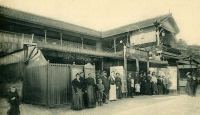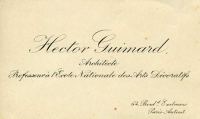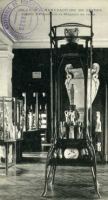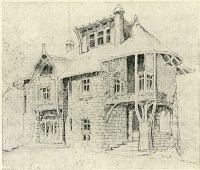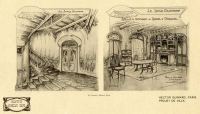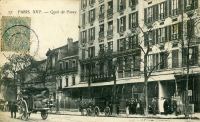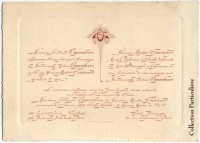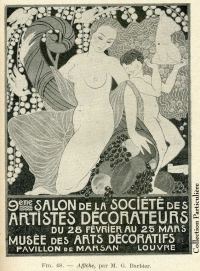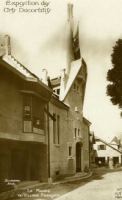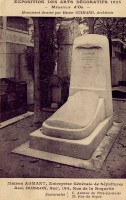Biography
(including architectural projects)
– 1867: Hector Germain Guimard is born at Lyon on 10 March.
– 1882: Candidacy for the National School of Decorative Arts.
– 1883: He is accepted by the Architecture Section of that School.
– 1885: Having graduated from the Decorative Arts School, Guimard passes the entrance exam for the Architecture Section of the Fine Arts School and admitted to the second year class of Gustave Raulin. He remains at the Fine Arts School until 1887, while beginning his career as an architect. Having passed the School’s age limit of 30 years he doesn’t attempt to receive a diploma from it.
– 1888: At the beginning of the year, he participates in the public competition to design the Town Hall of Calais.
– 1888: He builds the “Au Grand Neptune” Café-Concert Restaurant: 148 quai d’Auteuil (today quai Louis Blériot) in the XVIth district of Paris. Destroyed about 1910.
– 1889: The Electricity Pavilion at the Universal Exhibition. Destroyed.
– 1889: Guimard enters the first-year class of the Architecture Section of the Fine Arts School.
– 1889: The Lécolle Apartment House: 122 avenue des Batignolles (today avenue Gabriel Péri) in the Paris suburb of Saint-Oouen, Seine-Saint-Denis département.
– 1891: The Roszé townhouse: 34 rue Boileau, Paris XVIth district.
– 1891: The Hannequin Pavilions: 145 avenue de Versailles, Paris XVIth. Destroyed in 1926.
– 1891 : Draft proposal for the entryway to the Guimard Gymnasium, for his father Germain Guimard : 122 boulevard Malesherbes, Paris XVIIth.
– 1892: Twin Lécolle Houses: 142 rue du Vieux Pont de Sèvres, Boulogne Billancourt, Hauts-de-Seine département. Destroyed around 1912.
– 1892 : Rose Hunting Pavilion : 14 – 14ter rue des Tilleuls, Limeil-Brévannes, Val-de-Marne département. Destroyed around 1960.
– 1892 : Victor Rose burial monument : Batignolles Cemetery, Paris XVIIth.
– 1893: Draft proposal for a townhouse at 44 boulevard Jourdan, Paris XVIth.
– 1893: Jassedé Townhouse, 41 rue du Point du Jour (today rue Chardon-Lagache), Paris XVIth.
– 1893 : In August, Guimard moves into N° 64 boulevard Exelmans, Paris XVIth.
– 1893 : Villa Jassedé : 63 route de Clamart (today avenue du Général-de-Gaulle) ; Issy-les-Moulineaux, Hauts-de-Seine département.
– 1894 : Guimard takes part in the Salon of the National Society of Fine Arts.
– 1894: Funeral chapel for Devos-Logie and Mirand-Devos: Gonards Cemetery, Versailles, Yvelines departement.
– 1894: Guimard travels to Great Britain and paints some watercolor pictures.
– 1894: Delfau Townhouse: 1 ter rue Molitor, Paris XVIth. Modified about 1907.
– 1894-1895: Carpeaux Studio: 39 boulevard Exelmans, Paris XVIth.
– 1895 : Sacré Cœur (Sacred Heart) School : 9 avenue Frillière, Paris XVIth. Several modifications between 1939 and 1978.
– 1895: Rouchdy Bey Pacha burial monument: Gonards Cemetery, Versailles, Yvelines departement.
– 1895: Obry-Jassadé burial monument:
Issy-les-Moulineaux Cemetery, Hauts-de-Seine département.
– Giron, Mirel and Gaillard burial monument : Montparnasse Cemetery, Paris XIVth.
– 1896 : Villa Berthe : 72 rue de Montesson, Le Vésinet, Yvelines département.
– 1896 : Guimard exhibits at the Salon of the National Society of Fine Arts.
– 1896: Coutolleau Armory: 6 boulevard de Saumur (today boulevard du Maréchal Foch), Angers, Maine-et-Loire département. Destroyed about 1929.
– 1896 : La Boudinière Theater and Melrose Tearoom : 18 rue Saint-Lazare, Paris IXth. Destroyed about 1910.
– 1897: Villa Lantillon: 72 rue de Vaujours, Sevran, Seine-Saint-Denis département. Destroyed.
– 1897 : Guimard moves into the Castel Béranger (see 1895-1898 above).
– 1897: He exhibits his interior decoration of the Castel Béranger at the National Salon of Fine Arts.
– 1897: A dwelling porch presented at the Ceramics and “Fire Arts” Exhibition at the Fine Arts Palace, Paris. Destroyed.
– 1897: Guimard resigns from the National Fine Arts Society, showing solidarity with Anatole de Baudot.
– 1897-1898: Nelly Chaumier burial monument:
Bléré cemetery, Indre-et-Loire département.
– 1897-1898: Interior decoration for the Roy property : Les Gverils, Nogent-sur-Vernisson, Loiret departement. Dismantled.
– 1898: Roy Townhouse: 81 boulevard Suchet, Paris XVIth. Destroyed about 1960.
– 1898: Guimard resigns from his drawing professorship at the National School of Decorative Arts.
– 1898-1901: Humbert de Romans Concert Hall: 60 rue Saint-Didier, Paris XVIth. Destroyed in 1904-1905.
– 1898: Roucher Villas: 9 and 9 bis impasse Racine, Hameau Boileau, Paris XVIth. Transformed.
– 1898 : The Rouam Bookstore publishes an album devoted to the Castel Béranger: Art in Modern Dwellings.
– 1898: Maison Coilliot: 14 rue de Fleurus, Lille, Nord département.
– 1899 : Canivet Villa, 18 avenue du Parc de Beauveau-Craon (today avenue Alphonse-de-Neuville), Garches, Hauts-de-Seine département. Transformed.
– 1899 : « La Bluette » Villa : 272 rue Pré-de-l’Ile, Hermanan-sur-Mer, Calvados département.
– 1899 : The Castel Béranger is prizewinner in the Facade Competition organized by the City of Paris.
– 1899: At the beginning of April an exhibition on the Castel Béranger is held at the newspaper Le Figaro.
– 1899: 7 June – the death of the architect’s father, Germain Guimard.
– 1899: Castel Henriette: 46 rue des Binelles, Sèvres, Hauts-de-Seine département. Destroyed in March 1969.
– 1899 : Guimard designs the cover of the first number of the Revue d’Art.
– 1899: 27 December – the death of the architect’s mother.
– 1899: Burial monument for Ernest Caillat : Père-Lachaise Cemetery, Paris XXth.
– 1899-1900 : The « La Sapinière » House : 561 rue Pré-en-l’Ile, Hermanville-sur-Mer, Calvados département. Disfigured.
– 1900 : Draft proposal for a « People’s University » : Paris XVth.
– 1900 – 1903: Kiosks and stations for the Paris Métro (subway/underground).
– 1900: Guimard participates in the Universal Exhibition, presenting elements of the Castel Béranger and the Humbert de Romans Concert Hall. He also designs the stands of the industrialist Dejardin and the Millot perfumery.
– 1900-1901: Dejardin pavilion and store: 10-12 impasse Boileau, Paris XVIth. Destroyed around 1925.
– 1901: Guimard takes part in the Exhibition of Arts Applied to the Decoration of Cloth.
– 1901: Castel Eclipse: 1 – 3 rue de l’Assemblée Nationale, Versailles, Yvelines département. Destroyed.
– 1902 : Guimard presents furniture, decorative elements and drawings at the Exhibition of Salon Prizes and Travel Grantees at the Grand Palais, Paris.
– 1902: Warehouses of the Nozal Company: 132 avenue de Paris (today: avenue du Président Wilson), La Plaine Saint-Denis, Seine-Saint-Denis department.
– 1902: Founding member of the “New Paris” association, created by Georges Bans with Frantz Jourdain.
– 1902: Draft proposal for a garden on the Champs-Elysées.
– 1902: Guimard creates the “Binelles Vase”, his third collaboration with the Sèvres Porcelain Factory, for which he also designs a show window.
– 1902-1903: The Castel Val: 4 rue des Meulières, Chaponval, Auvers-sur-Oise, Val d’Oise département.
– 1902-1906 : Nozal Townhouse : 52 rue de Ranelagh, Paris XVIth.
– 1903 : Nozal Workshops : 12 avenue Perrichont-prolongée, Paris XVIth. Destroyed around 1960.
– 1903: Comemmorative monument to Paul Nozal: La Tatre, Charente departement.
– 1903 : « The Guimard Style » Pavilion at the Dwelling Exhibition : Grand Palais, Paris ; VIIth. Destroyed.
– 1903: Guimard is a founding member of the Autumn Salon Society and at the first one exhibits several watercolors.
– 1903-1905: The Jassedé Apartment House: 142 avenue de Versailles and 1 rue Lancret, Paris XVIth.
– 1903-1907: “The Surprise” Villa: 13 avenue des Dunes (today: avenue du Maréchal Foch), Cabourg, Calvados département.
– 1903 : Draft proposal for a « French Memory » monument.
– 1904: Beginning of January – Guimard presents decorative elements at the First Salon of Decorative Artists.
– 1904: Breach of the contract between the Paris Métro (underground/subway) Company and Guimard.
– 1904: Castel d’Orgeval: 2 avenue de la Mare-Tambour, Villemoisson-dur-Orge, Essonne département.
– 1904 : Draft proposal for the heightening of a small apartment house : 22 rue Chardon-Lagache, Paris XVIth.
– 1904: Guimard takes part in the Autumn Salon.
– 1904: Draft proposal for some country houses.
– 1904: Draft proposals for the Nozal offices: 9 quai de Passy, Paris XVIth.
– 1905 – 1907: Deron-Levent Townhouse: 8 villa de la Réunion, Paris XVIth. /Attention : Villa de la Réunion EXACT : CORRECTION A EFFECTUER DANS LE TEXTE FRANÇAIS ? MERCI /
– 1906 : Draft proposal for raising the Ledru Townhouse : 25 rue Erlanger, Paris XVIth.
– 1906: “April Rose” Villa (« Rose d’Avril »): avenue de la Pépinière, Morsang-sur-Orge, Essonne département. Destroyed.
– 1906 : « Moonlight Villa » (« Clair de Lune ») : 18 avenue du Muguet, Morsang-sur-Orge, Essonne département. Transformed.
– 1907 : Guimard takes part in the 3rd Salon of Decorative Artists.
– 1907: Guimard designs and produces the furniture and interior decoration of the Villa Desagnat: 5 bis avenue du Maréchal Foch, Saint Cloud, Hauts-de-Seine département. House destroyed and furniture scattered around 1980.
– 1907: Huin Store: Montrouge, Hauts-de-Seine département. Destroyed ( ?)
– 1907 : Grunwaldt Chapel : Neuilly-sur-Seine Cemetery, Puteaux, Hauts-de-Seine .département
– 1908 : In July, Guimard takes part in the Franco-British Exhibition at London.
– 1908: In November, Guimard exhibits art objects at the 4th Salon of the Decorative Artists’ Society.
– 1909: Guimard undertakes a study tour in Germany and Austria.
– 1909: The White Chalet (Chalet Blanc): 2, rue du Lycée, Sceaux, Hauts-de-Seine département.
– 1909-1910 : Villa : 16 rue Jean Doyen, Eaubonne, Val d’Oise département.
– 1909 : On 17 February, Guimard marries Adeline Oppenheim, a painter from New York.
– 1909-1912 : The Guimard Townhouse : 122 avenue Mozart, Paris XVIth.
– 1909: In July, Guimard takes part in the French Exhibition of Decorative Art at Copenhagen.
– 1909-1910: The Trémois Apartment House: 11 rue François Millet, Paris XVIth.
– 1909 : Publication of a catalogue of cast-iron art objects with the Saint-Dizier Foundry.
– 1910-1911: A cluster of apartment houses: 17-19-21 rue La Fontaine, 43 rue Gros and 8-10 rue Agar, Paris XVIth.
– 1910: Guimard exhibits at the 5th Salon of the Decorative Artists’ Society.
– 1910-1911: The Mezzara Townhouse: 60 rue de La Fontaine, Paris XVIth. Listed as an historical monument in 1975.
– 1910 : Guimard takes part in the First Official Exhibition of Students and Graduates of the Fine Arts School.
– 1910: Draft proposals for apartment houses: 148 quai d’Auteuil and 147 avenue de Versailles, Paris XVIth.
– 1911: Guimard exhibits drawings, photographs and furniture at the International Exhibition of Work-related Industries at Turin.
– 1911: Du 23 février au 26 mars, Guimard participe au 6ème Salon de la Société des Artistes Décorateurs. Il présente des photographies de l’immeuble du 6 rue François-Millet (façade et intérieurs) ainsi que des éléments mobiliers et des bijoux.
– 1912: At the 7th Salon of.the Decorative Artists’ Society, Guimard exhibits photographs of the apartment house cluster on rue La Fontaine, rue Gros and rue Agar.
– 1912: Deron Levent burial monument: Auteuil Cemetery, Paris XVIth.
– 1913: Guimard again exhibits photos of the La Fontaine, Gros and Agar apartment houses at the 8th Salon of the Decorative Artists’ Society.
– 1913: Hemsy Villa: 3 rue de Crillon, Saint-Cloud, HAuts-de-Seine département. Transformed.
– 1913 : Synagogue : 10 rue Pavée, Paris IVth.
– 1913 : Draft proposal for a townhouse : rue Jean-Daudin, Paris XVth.
– 1913: Guimard is selected to join the jury at the Autumn Salon.
– 1914: Nicolle-de-Montjoye townhouse: 7 rue Pierre-Ducreux (today rue René Bazin), Paris XVIth. Destroyed.
– 1914-1920 : An office building : 10 rue de Bretagne, Paris IIIrd
– 1914 : Guimard exhibits at the 9th Salon of the Decorative Artists’ Society.
– 1914: Draft proposal for property development: rue Henri-Heine, rue Jasmin, rue Pierre-Ducreux and rue Robert-Turquan, Paris XVIth.
– 1920: Heightening of the Barthélémy Townhouse: 53 rue Ranelagh, Paris XVIth. Destroyed.
– 1920: Commemorative monument: Michelet Highschool, Vanves, Hauts-de-Seine département.
– 1921 : Bastien Garage : 34 rue Robert-Turquan, Paris XVIth. Destroyed.
– 1921 : Commemorative monument : Montiers-sur-Saulx, Meuse département. Destroyed in 1974.
– 1921-1922 : Standardized town house : 3 square Jasmin, Paris XVIth.
– 1922: Albert Aldès burial monument. Montparnasse Cemetery, Paris XIVth.
– 1923: Guimard is named Vice-President of the Group of Modern Architects in preparation for the 1925 International Exhibition of Modern Decorative and Industrial Arts.
– 1925: A “French Village Town Hall” for the International Exhibition of Modern Decorative and Industrial Arts in Paris. Destroyed.
– 1925: A tomb for “A French Village Cemetery” at the same Exhibition. Destroyed.
– 1925: Guimard exhibits at the Exhibition of Renovators of Applied Arts from 1890 to 1910.
– 1926: Takes part in an exhibition of French architecture in New York.
– 1926: The Guimard Apartment House: 18 rue Henri-Heine, Paris XVIth.
– 1926-1927: Houyvet apartment house: 2 villa Flore, Paris XVIth.
– 1927-1928: Buildings for rental apartments: 36 and 38 rue Greuze, Paris XVIth.
– 1929: Guimard is named Knight of the French Legion of Honor.
– 1929: Draft proposal for a monument commemorating the Marne Victory: Mondement, Marne département.
– 1930: Draft proposal for museums.
– 1930: Hector and Adeline Guimard move into the Guimard Apartment House at 18 rue Henri Heine (see under 1926 above).
– 1930: “La Guimardière” villa: rue Le Nôtre, Vaucresson,Hauts-de-Seine département. Destroyed.
– 1933 : Guimard takes part in the exhibition on « The Decoration of Life During the Third Republic from 1870 to 1900” at the Marsan Pavilion (Louvre, Paris Ist).
– 1937: He is a jury member for the “Architecture” category at the “Decoration of Life from 1900 to 1925”, exhibition” at the Marsan Pavilion (Louvre, Paris Ist).
– 1938: The Guimards leave France by ship for the United States, and settle at Adams Hotel in New York.
– 1942: On 20 May, Guimard dies in New York.

